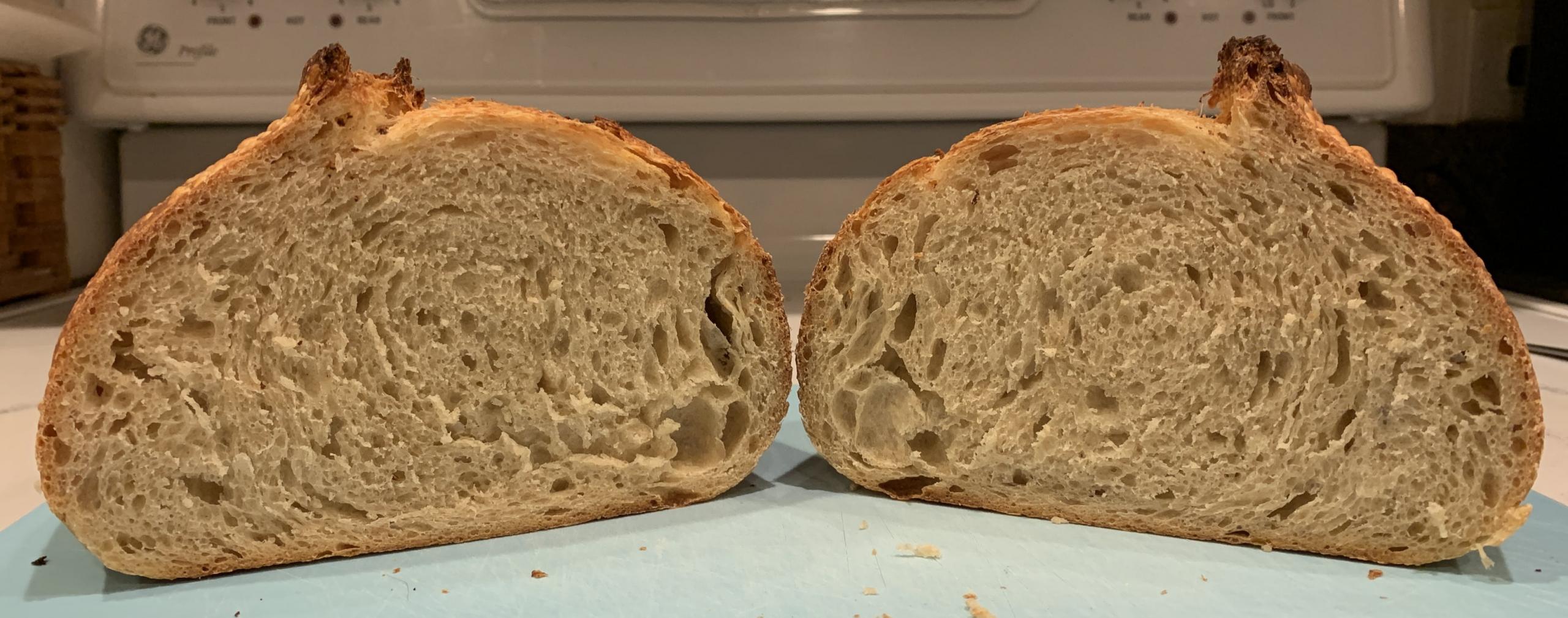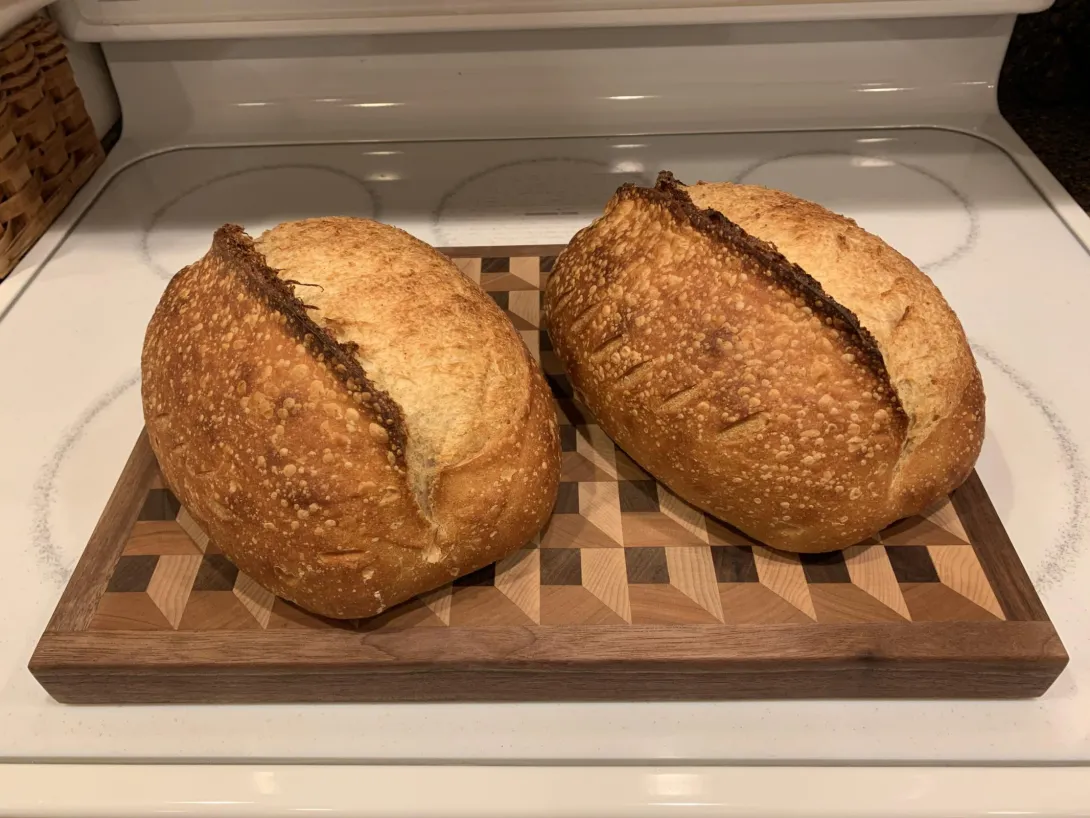
It's been a long time coming, but I finally got around to doing a side-by-side comparison of a bake with and without raisin yeast water. One caveat... any of you that have followed my posts may remember when my yeast water that I made with honey and raisins went sour and noticeably acetic. I thought it was the new batch of raisins I had purchased, but it happened again with a brand new YW with new organic raisins. So now, I think it may be the honey. This should have been a test to see how YW smooths out any sourness, but in this case, it was how it added to it. :-) In reality, this worked out well because my starter (all white flour at 120% hydration) lacks any real acetic tones. It's very yogurty.
On to the bake...
Loaf 1
225g AP Flour (Wheat Montana)
158g Bread Flour (Wheat Montana)
23g Whole Wheat Flour (King Arthur)
23g Sifted Durum Flour (Janie's Mill)
11g Barley Flour (Food to Live)
11g Dark Rye Flour (Bob's Red Mill)
302g Water (67% hydration)
9g Sea Salt
18g Sourdough Starter
Loaf 2
All the same flours and salt
189g Water (42% hydration)
113g Raisin Yeast Water (25% hydration)
13g Sourdough Starter
Method
1) Combine all ingredients and mix till fours are wetted.
2) Bench rest 30 minutes
3) Bowl kneading till some dough resistance (24 folds)
4) Bench rest for 30 minutes
5) Bowl kneading till smooth dough surface (12-15 folds)
6) Bulk ferment 76 deg with S&F every 60 minutes until dough is just starting to get "puffy" (7-8 hours)
7) Continue bulk until dough roughly doubles (80-100%)
8) Pre-shape, bench rest, final shape
9) Final proof at 76 deg F for 2 hours
10) Cold retard overnight (6-8 hours)
11) Pre-heat oven to 460 deg F for 40 minutes
12) Pre-steam oven, load dough and bake for 1 minute at 460 deg F; lower oven to 425 deg F (15 minutes); vent oven and empty residual water in steam tray; 425 deg F (15-20 minutes). Bake done when hollow thump on bottom.
Observations
1) Both doughs were slightly sticky at mix but immediately smoothed out after first kneading
2) RYW dough was a little stronger/stiffer from initial mix
3) RYW dough was a little slower in bulk and final proof. Guessing the amount of RYW used did not compensate for the drop in starter inoculation.
4) Both loaves had very similar bloom/spring.
5) RYW loaf has a slightly more closed crumb. Not sure if that's due to fermentation or slight differences in degassing/shaping. Would need to do it again to see if it's consistent.
6) RYW loaf had a more noticeable tang to both aroma and taste (as expected with my "sour" RYW). Both breads were very good. I think I liked the tang a little more.
7) Side note... I used a pizza stone instead of my baking steel for these loaves. Have been fighting very tough, leathery bottom crust since starting with my steel. Had to drop pre-heat temps to 375 deg F to avoid it and then try to ramp temp at the end to get color into the crust. Not an issue with the stone, and really happy with the bloom and spring on both loaves.
Straight SD loaf left. RYW/SD loaf on right.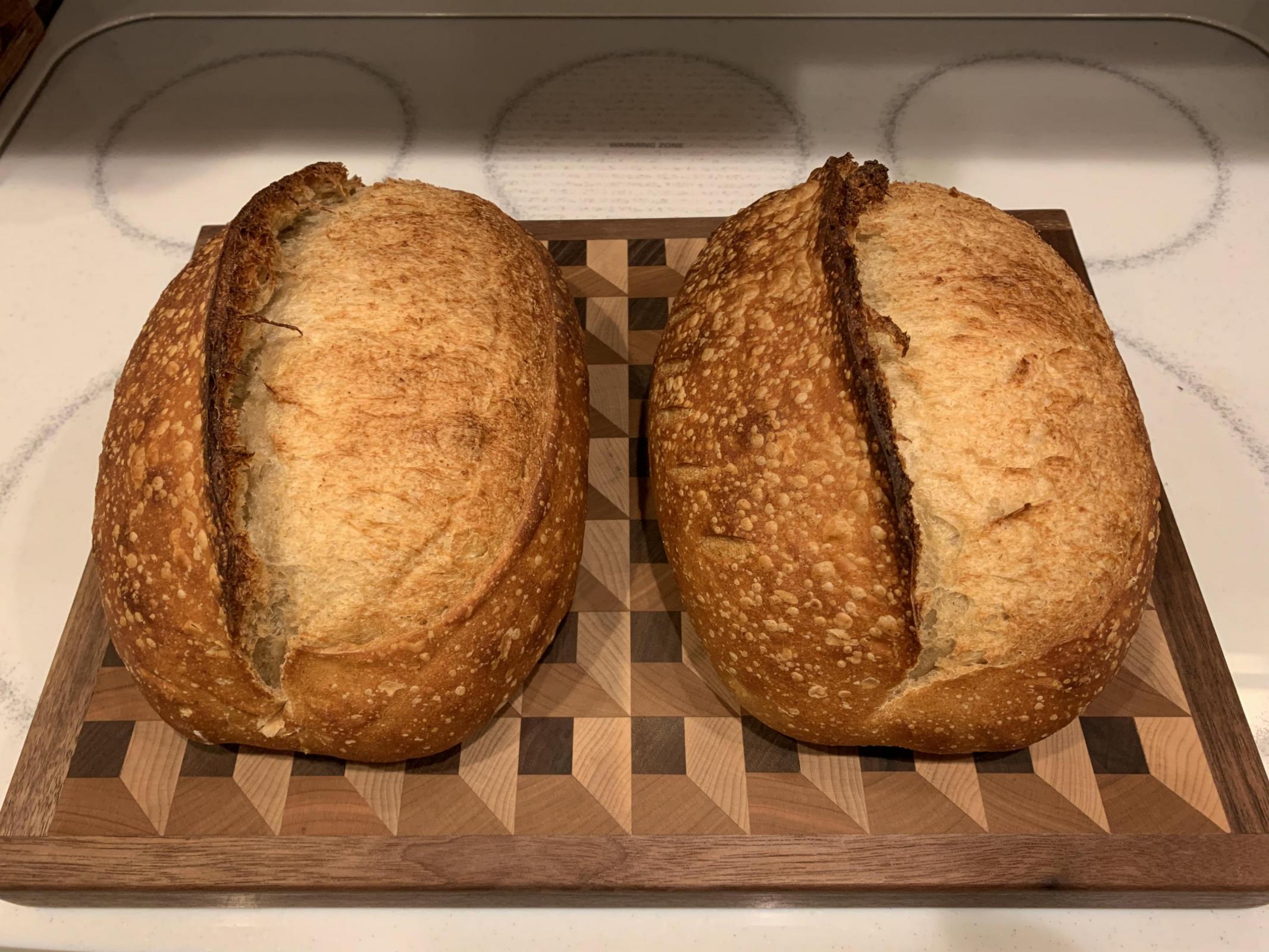
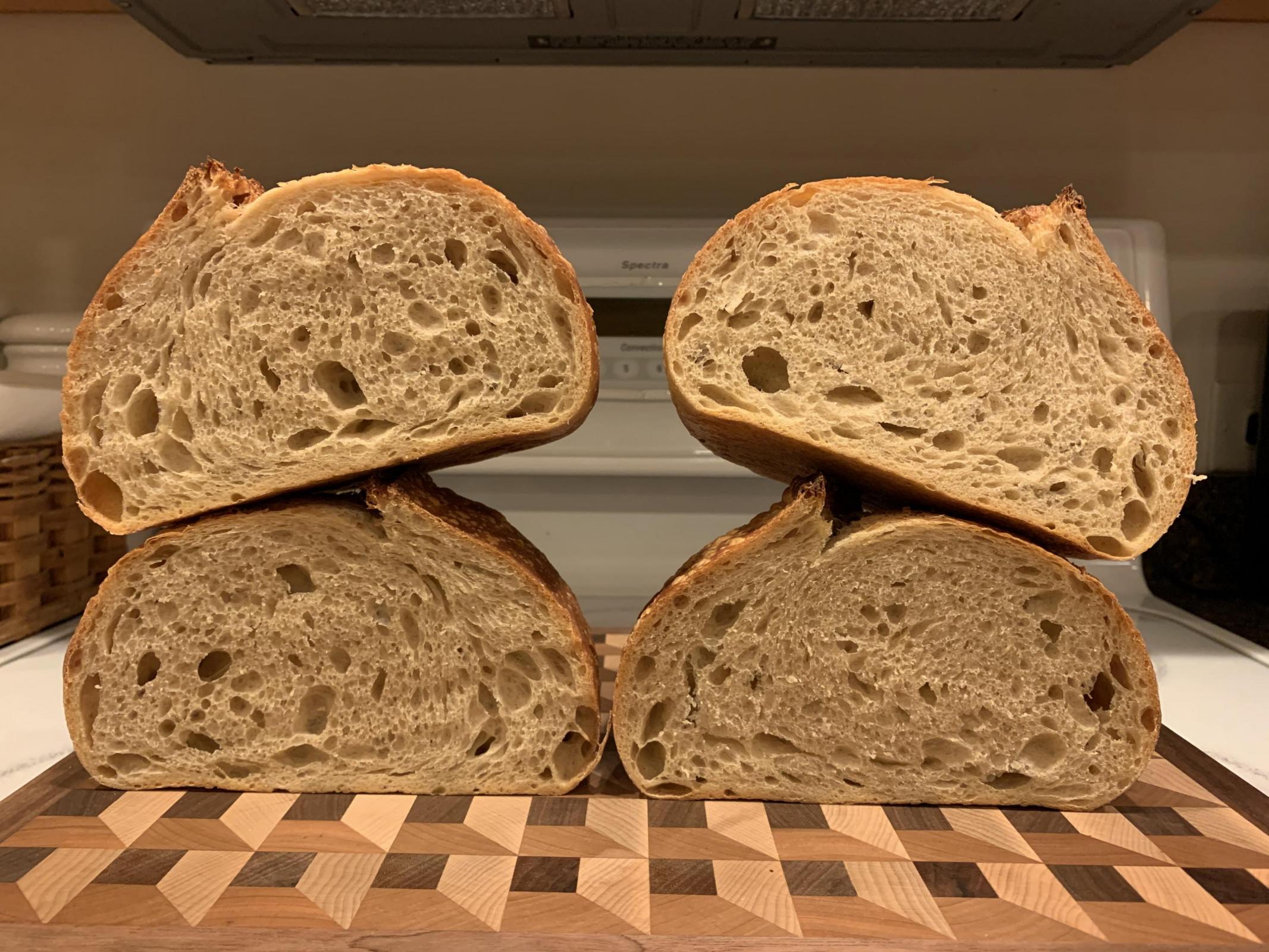
Straight SD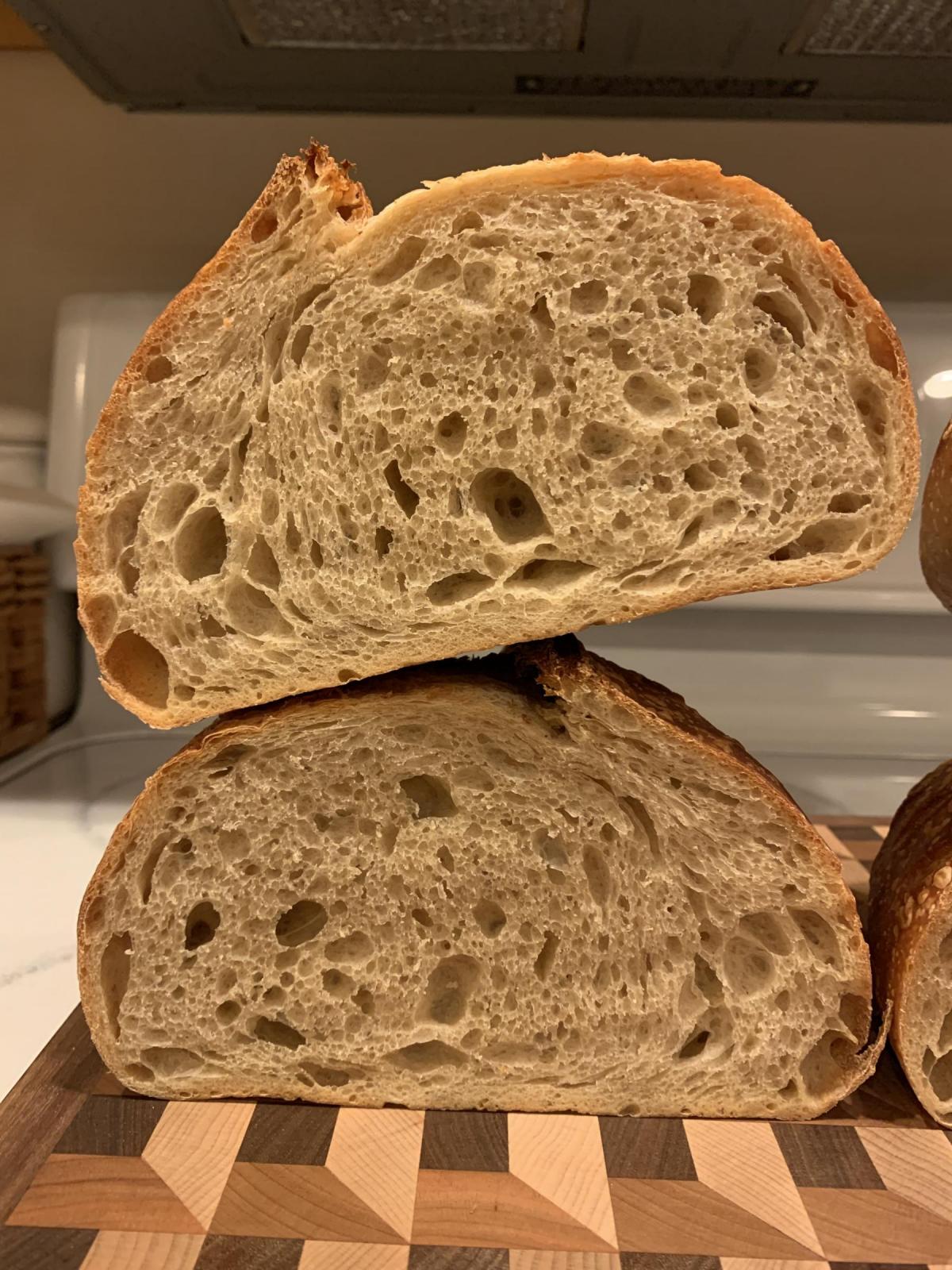
RYW/SD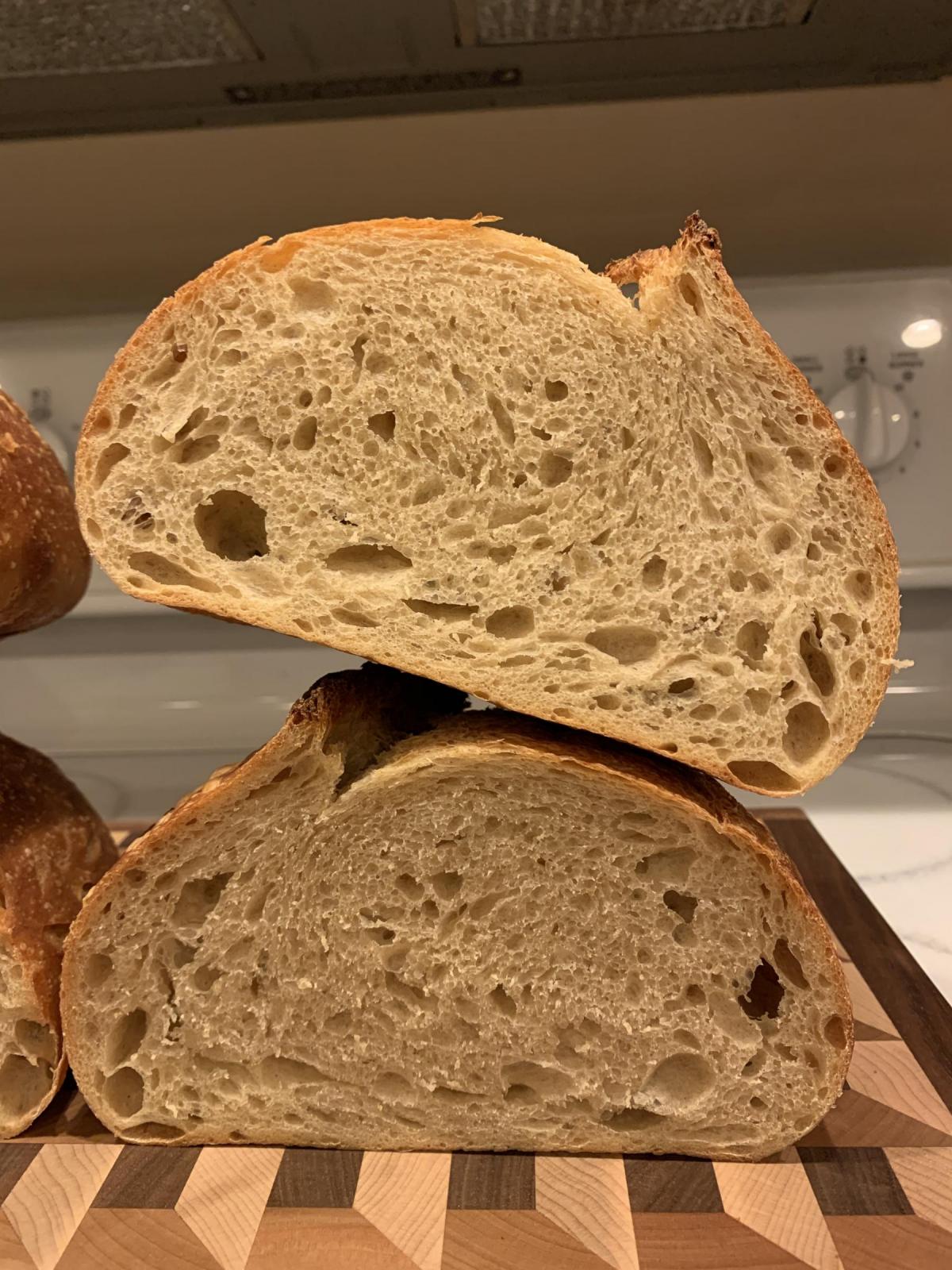
- HeiHei29er's Blog
- Log in or register to post comments
Very nice comparisons. As to YW and honey they do not mix in my experience and from my chemist husband’s explanation when I asked him why. He’s asleep so can’t get a quote but you can use sugar if you feel you need to but never honey direct into the YW. It’s fine of course in the bread dough itself.
Glad your experiment turned out so well! c
Thank you Caroline!
Will be interested in hearing your hubby's explanation if he can share it again. I'm a chemical engineer and love the chemistry/biology involved in baking. :-)
Beautiful loaves Troy, both are just wonderful. It really is hard to say that one of the crumbs is that much more open than the other.
Remind me why/how you’re using the honey in the yeast water? Were you adding it for the sugar to give the yeast more food? Have you compared the acidity to a plain raisin yeast water without the honey?
Benny
Thanks Benny! I was really happy to get the softer bottom crust but also a nice bloom with the stone. Re-thinking the oven setup now...
When I first tried making a YW, I was surfing YouTube/Google. Was directed to this video by another "How to" video. He makes the initial with sugar but mentions sugar (or honey) in the refresh discussion later in the video. I'm a big honey fan, so that was a no-brainer decision for me. I tried this method and it worked great for over a year, so I never questioned it.
https://www.youtube.com/watch?v=l8jbrE-BB9U&t=305s
I buy raw honey from the same local bee keeper, usually 10-15 pounds at a time. The change in YW seems to have happened with the most recent batch I picked up.
I see you’re using raw honey, so unpasteurized. So LAB from the flowers and thus on the bees and in the honey could be the cause of your raw honey RYW creating levains that are more acidic. It would be interesting to see what would happen if you used pasteurized honey in your RYW, presumably the LAB would be killed during pasteurization.
That's what I'm leaning towards too... I'm actually doing a test bake today on a straight RYW (may use just a pinch of IDY to give it a boost) to see if it has the strong acetic tones I'm anticipating. If it does and the crumb texture doesn't come out too chewy, I will probably try to perpetuate it and use it as a way to get the acetic tones. Leave my SD starter yogurty and lactic.
He's adding salt. I wonder why?
Not sure... It works out to about 0.5%, so not a big addition.
Beautiful bloom, spring and crumb, lovely breads Troy.
I always like to read your experiments, and they always make me think. I'm not sure enough with my yeast water if I can use it directly - if it will help things along as much as if it had spent 5-12 hours in growing a preferment first.
Thanks Jon. I had the same concern about the strength of the YW (mine has been weak before and I can't always tell when it will be), so today's all RYW bake has a 30% PFF levain at 100% hydration. Put that going last night... It's a deviation from what I did with the SD loaves, but schedule is a little tight today and I wanted to make sure I would have a reasonable bulk ferment time.
Levain rose nicely overnight, and in hind sight, I probably didn't need the pre-ferment. But... better safe than sorry in this case.
Beautiful loaves, HeiHei, and food for thought, too. Somewhere along the line, I added raw honey in the apple yeast water for my dough that went funky – mainly because my YW doughs seemed to be slowing down and I thought honey would give it a little shot in the arm. After reading this thread, I guess it was bad medicine. I didn't add more honey when I remade the batch, but I did inoculate it with about a tablespoon of the old YW. Hopefully its affects will be minimal. So much to learn, even about seemingly innocuous things like honey. Nice bake and interesting post, thank you.
–AG
Thanks AG! I'm not sure it's bad medicine just yet. There are so many variables at play... At this point, I'm just trying to narrow down what is making the YW sour. The levain I made last night worked well. Was nice and bubbly in 10 hours at 78 deg F. I did not add any ADY to the final mix because the levain looked good. Bulk for today's loaf (same flours and hydration only with all RYW and using a 30% PFF) was done in 6.5 hours from initial mix. So much to learn!
The both breads look good. To me the SD is the winner by a nose. It looks like your stone needs to be hotter because the bottoms are a little pale but that’s just me preferring a bold bake. I have been leaving my YW on the counter and feeding it a pinch of white sugar once a week when the raisins start to sink. They float again and fizz after a shake. Learning to trust the YW is a leap of faith. Thanks for sharing.
Don
Feeding only a pinch of sugar once a week on the counter? It does not sound like much, as I feed mine 5% of brown sugar everyday out on the counter, as that is the only way I found that would have it make wine and stay active. In the fridge I feed it once a week, again with a 5% of the liquid. Mine tastes like wine, very sweet wine.
Thanks Don, and agree on the pale crust. The stone has taken me in the other direction, but I think it will be easier to dial in the bottom crust with the stone instead of the steel. I could dull knives with some of the bottom crusts off the steel. :-)
Great comparison bakes Troy, very interesting, can't wait to see a loaf with YW as a sole levaining agent without instant yeast.
If nothing else, the method is consistent. :-)
Due to a few past experiences where the YW was a little weak without an initial build, I decided to use a 30% PFF levain with this loaf. The levain was made last night and consisted of Wheat Montana bread flour and RYW at 100% hydration. Fermented overnight at 78 deg F and it was nice and bubbly after 10 hours. Bulk fermentation was done a little sooner (6.5 hours vs 8 hours) and final proof was the same at 2 hours (both bulk and final at 76 deg F).
Loaf 3 is the same flours as the previous loaves and has the same hydration at 67%. Only difference here is the levain and all the hydration is from the "sour" raisin yeast water. The yeast water does not smell sour or taste vinegary. The best description I can give is it smells and tastes like honey flavored soda water. Smells honey sweet and has the soda water crispness to taste.
From the oven, this one likely has the most sour/acetic tones of the three (the other two are gone so can't compare directly). It also darkened up more, and I'm guessing that's residual sugar from the honey in the YW. Will get a crumb shot tomorrow morning after it's had time to sit and cool. Bloom looks very similar, but think this one might be a bit more dense.
Fermentation doesn’t look too bad, but crumb is a little gummier. I degassed this one harder than the others to try and eliminate the larger holes. It does have a more sour aroma. This is a “heavier” loaf. Will have to try it without the levain next time.
